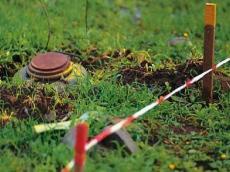|
|
TODAY.AZ / Politics
Mine explosion in Gazakh is part of theatre Armenia playing for months
30 April 2024 [18:00] - TODAY.AZ

Fatime Letifova
Yesterday, a mine explosion in the Gazakh region of Azerbaijan resulted in the injury of an employee of the State Border Service. It is worth noting that previously, in July 2020, Gazakh became a site for clashes with Armenia. Finally, in April of this year, Armenia and Azerbaijan reached an agreement whereby Armenia handed over four villages within Gazakh District to Azerbaijan. During these 4 years, the Armenian side tried to hinder the process by creating problems and wanted to gain time regarding the return of the 4 Azerbaijani villages.
The point is that although the mine explosion in the recently returned village of Gazakh raised similar suspicions, the different versions raised some questions as well. Currently, two issues raise questions: Is the mine explosion in Gazakh a coincidence, or did the Armenians lay mines in this region in a very short time?
And finally, the injury of an Azerbaijani military serviceman as a result of an explosion reflects the example of the next Armenian provocation.
In a comment for Azernews on the issue, the former military attaché of Turkiye in Azerbaijan, General (Brigadier) Yucel Karayuz, noted that investigations will let us know whether mine is new or not.
“First of all, I wish a speedy recovery to the injured soldier. Of course, as a result of the crime scene investigation, it will be found out whether this mine was laid years ago or was newly laid while negotiations were ongoing," the military expert said.
He said that this act could be the result of Armenian opposition groups’ provocations.
“Whether it is old or new, it is actually about the approach of Armenia and different forces within Armenia. This may be an incident committed by a group that wants to undermine the process of normalisation against the Pashinyan government," the general added.
The expert reminded the Ottawa Convention regarding this issue. Recall that the Ottawa Convention is also known as the Mine Ban Treaty. It aims at eliminating anti-personnel landmines (APLs) around the world.
“Whether planted by the government, the army, or the opposition in Armenia, ultimately, mines are a crime against humanity and something that is prohibited and should not be used according to the Ottawa Convention," Yucel Karayuz noted.
The general also added that this is not a coincidence. Mines are the specific weapons that need specific use.
“The mine explosion in Gazakh cannot be a coincidence. What we call a mine is a weapon that is planted according to a certain key and laid by the scattering method, just like in the fields," the expert said.
Karayuz stressed that the Azerbaijani serviceman's injury should be considered the next Armenian provocation.
“Of course, the injury of the Azerbaijani soldier is one of Armenia's latest provocations and a part of supporting the theatre it has been playing for months," he added.
The military expert noted that the Azerbaijan National Agency for Mine Action (ANAMA) is on mission to discover all the mines in the liberated territories, including Gazakh’s villages.
“In fact, ANAMA will carry out mine search and scanning activities in the regions, especially around the four recaptured villages. A healthy life may be possible in these regions only after normalisation and once the cleaning work is completed. It is not stated, but I am sure that ANAMA has now started this activity in Gazakh,” he underlined.
The expert touched on Azerbaijan’s mine problems caused by Armenia. He also said that Azerbaijan is one of the most experienced countries in this field.
“As we know, these activities continue at a high rate, especially after Garabagh was liberated. Azerbaijan is a state with the highest international experience in this regard,” the Turkish general emphasised.
It is worth noting that almost on a daily basis, Azerbaijani civilians face deadly remnants of war—landmines planted by Armenia. Throughout the period of conflict and the Armenian occupation of Azerbaijan’s territories, Armenia indiscriminately planted hundreds of thousands of mines and other explosive devices in the territories, including the areas where civilians lived.
More than 70% of landmine victims are civilians. Among them are people of all age categories. Despite attempts at formally requesting information about the location of those mines, Armenia repeatedly denied that it possessed the relevant information and refused to engage on the issue.
Finally, in February of this year, Armenia submitted 8 minefield maps of territories located in the liberated lands to Azerbaijan. These maps cover some of the areas along the former contact line. However, the maps covering part of the former contact line passing through Khojavand, Tartar, and Goranboy districts, as well as the areas mined by Armenian military units when they retreated in November 2020, have not been submitted yet.
Many have suspicions about these maps because previous minefield maps submitted by Armenia were inaccurate. According to the agency, only 25 percent of these maps were correct. Especially submitting minefield maps of the heights where civilians do not live increases this suspicion. It is also worth noting that more than 55% of recent landmine cases have occurred outside the areas covered by the information provided.
The behaviour that Armenia displayed in relation to the landmine threat is indeed another setback to the peace-building and confidence-building measures taken during the post-conflict period in the region.
It is worth noting that as Azerbaijan's liberated territories remain contaminated with mine, the new infrastructure and green energy projects remain a risky and problematic goal. These obstacles to a legal peace are part of the challenges facing the repopulation, development, and integration of the liberated territories on the path to a full peace.
URL: http://www.today.az/news/politics/247738.html
 Print version
Print version
Connect with us. Get latest news and updates.
See Also
- 11 December 2025 [11:38]
Azerbaijan, Kenya praise strengthening ties at high-level meeting in Nairobi - 11 December 2025 [11:19]
US lawmaker moves to repeal Amendment 907 restricting aid to Azerbaijan - 11 December 2025 [11:11]
The intricacies of diplomacy: why is the 3+3 meeting postponed? - 11 December 2025 [09:30]
President Ilham Aliyev: Current level of Azerbaijan–Kenya relations a source of satisfaction - 11 December 2025 [09:05]
President Ilham Aliyev sends congratulatory letter to President of Kenya - 10 December 2025 [15:43]
Baku, Tashkent sign 2026 military cooperation plan - 10 December 2025 [13:42]
Bucharest holds roundtable on “Heydar Aliyev’s Role in Establishing Relations Between Azerbaijan and Romania” - 10 December 2025 [13:21]
President Ilham Aliyev receives UK and Northern Ireland Trade Envoy to Azerbaijan - 10 December 2025 [11:56]
President Ilham Aliyev received President of John Deere for CIS and Central Asia - 10 December 2025 [11:02]
Azerbaijan, US explore investment and digital partnership opportunities
Most Popular
 Parallel worlds of European Union and South Caucasus
Parallel worlds of European Union and South Caucasus
 Minorities Rights Bill 2025 passed: Pakistan creates autonomous watchdog for religious minorities
Minorities Rights Bill 2025 passed: Pakistan creates autonomous watchdog for religious minorities
 Georgia allows one-time free transit of Azerbaijani oil products to Armenia
Georgia allows one-time free transit of Azerbaijani oil products to Armenia
 President Ilham Aliyev receives CEO of Global Infrastructure Partners
President Ilham Aliyev receives CEO of Global Infrastructure Partners
 OIC Culture Festival strengthens unity across Islamic world
OIC Culture Festival strengthens unity across Islamic world
 Speaker Gafarova highlights Parliament’s role in shaping future of Azerbaijani language
Speaker Gafarova highlights Parliament’s role in shaping future of Azerbaijani language
 Afghanistan expands international flight connections
Afghanistan expands international flight connections
